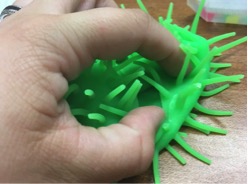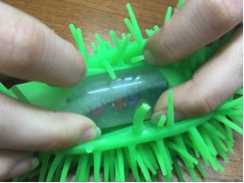Overview: Bacteria Modeling
Objectives
Students will understand what bacteria look like with a model they create. They will also learn vocabulary associated with bacteria.
Lesson Preparation
- KWL of a Microbiologist: knows (K), wants to know (W), and has learned (L)
- Read book "What are Bacteria, Viruses, and Fungi?" by Tripti Nainwal Pages 2 & 3
- Explain what a bacteria is and what it looks like (Figure 1 in Lesson Materials).
- Explain the scale of bacteria (Figure 2 in Lesson Materials).
- Watch the Youtube video about Skin located at the bottom of the lesson.
- Explain the shapes of bacteria (Figure 3 in Lesson Materials).
Materials & their Bacteria component counterpart
Alternative materials can be substituted if creating kits outside of the classroom or at home.
- Test tube: Capsule
- Beads: Ribosomes and Plasmids- Bacteria protein insides
- Pipe Cleaner: nucleoid (circular DNA)- where genetic info is stored
- Squish Ball: Membrane with Pilli - the outside protective layer of a bacteria
- Ribbon: Flagellum - bacteria tail
- Hand Sanitizer: Cytoplasm - the gooey insides of bacteria
Procedure
Create the Bacteria Craft (based on bacillus shape).
Fill the test tube with the hand sanitizer (3/4s of the way) and add some orange and yellow beads.

The inside tube of the bacteria. Twist the pipe cleaner down the middle, fill the rest of the tube with the hand sanitizer. Close the test tube tightly.

Place the tube inside the slit of the squish ball. Next take the squish ball and make a small slit to insert your test tube.

Cut slit into the Squish Ball. You can stretch out one of the pilli for a flagellum or add a ribbon onto the craft as well.
Examine the inside of your bacteria.

Examine the inside of your bacteria.
Resources
Book: "What are Bacteria, Viruses, and Fungi? Written by: Tripti Nainwal
Image of Bacteria: http://lyceum.algonquincollege.com/lts/onlineCourses/anatomy/App_Themes/e-learning/images/diagrams/module15-4_15-4_bacteria.png
Author/ Credits
Dieuwertje Kast, 2016 PolarTREC Educator
Director of STEM Education Programs, USC
Los Angeles, CA
dkast [at] usc.edu
Referenced from: https://angelicscalliwags.com/2014/06/02/project-based-learning-microbes-bacteria/
Standards Other
Next Generation Science Standards
5-LS2-1. Develop a model to describe the movement of matter among plants, animals, decomposers, and the environment
[Clarification Statement: Emphasis is on the idea that matter that is not food (air, water, decomposed materials in soil) is changed by plants into matter that is food. Examples of systems could include organisms, ecosystems, and the Earth.] [Assessment Boundary: Assessment does not include molecular explanations.]
LS2.A: Interdependent Relationships in Ecosystems
The food of almost any kind of animal can be traced back to plants. Organisms are related in food webs in which some animals eat plants for food and other animals eat the animals that eat plants. Some organisms, such as fungi and bacteria, break down dead organisms (both plants or plants parts and animals) and therefore operate as “decomposers.” Decomposition eventually restores (recycles) some materials back to the soil. Organisms can survive only in environments in which their particular needs are met. A healthy ecosystem is one in which multiple species of different types are each able to meet their needs in a relatively stable web of life. Newly introduced species can damage the balance of an ecosystem.
LS2.B: Cycles of Matter and Energy Transfer in Ecosystems
Matter cycles between the air and soil and among plants, animals, and microbes as these organisms live and die. Organisms obtain gases, and water, from the environment, and release waste matter (gas, liquid, or solid) back into the environment.
| Attachment | Size |
|---|---|
| Full Lesson: DIY Microbe! (PDF - 1009 KB)1009.06 KB | 1009.06 KB |
| Lesson Materials773.01 KB | 773.01 KB |
This program is supported by the National Science Foundation. Any opinions, findings, and conclusions or recommendations expressed by this program are those of the PIs and coordinating team, and do not necessarily reflect the views of the National Science Foundation.
